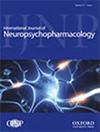咪达唑仑对照试验中的急性解离与氯胺酮的抗抑郁和抗自杀意念作用
IF 3.7
2区 医学
Q1 CLINICAL NEUROLOGY
引用次数: 0
摘要
目的 在一项咪达唑仑随机对照试验中,探讨静脉注射氯胺酮的急性解离效应与抑郁和自杀意念的变化以及血浆代谢物水平之间的关系。方法 利用随机使用氯胺酮的有自杀倾向的抑郁症患者(40 人)的试验数据,研究氯胺酮治疗引发的解离和拟精神症状与灌注前/后自杀意念和抑郁症严重程度变化之间的关系。研究采用了非参数相关统计方法。这些方法还被用于研究在输注后立即提供血液样本的子集(28 人)中解离性或拟精神症状与氯胺酮及代谢物血药浓度之间的关联。结果 氯胺酮的急性解离作用和拟精神作用均与注射前和注射后自杀意念或抑郁症状的变化无关。氯胺酮与注射后第1天的分离症状呈趋势性中度反相关(p = .064;去除一个离群值后,p = .013)。脱氢氯氯胺酮与 40 分钟(p = .034)、230 分钟(p = .014)和第 1 天(p=.012)的 CADSS 评分相关。结论 我们没有发现证据表明氯胺酮的急性、短暂解离或拟精神作用与其抗抑郁或抗自杀意念作用有关。在治疗后第一天,较高的血浆氯胺酮与较低的分离症状之间的相关性表明,分离可能更多的是母药的作用。本文章由计算机程序翻译,如有差异,请以英文原文为准。
Acute Dissociation and Ketamine’s Antidepressant and Anti-Suicidal Ideation Effects in a Midazolam-controlled Trial
Objective Explore relationships of acute dissociative effects of intravenous ketamine with change in depression and suicidal ideation and with plasma metabolite levels in a randomized, midazolam-controlled trial. Method Data from a completed trial in suicidal, depressed participants (N=40) randomized to ketamine was used to examine relationships between ketamine treatment-emergent dissociative and psychotomimetic symptoms with pre/post-infusion changes in suicidal ideation and depression severity. Non-parametric correlational statistics were used. These methods were also used to explore associations between dissociative or psychotomimetic symptoms and blood levels of ketamine and metabolites in a subset (N=28) who provided blood samples immediately post-infusion. Results Neither acute dissociative nor psychotomimetic effects of ketamine were associated with changes in suicidal ideation or depressive symptoms from pre- to post-infusion. Norketamine had a trend-level, moderate inverse correlation with dissociative symptoms on Day 1 post-injection (p = .064; p = .013 removing one outlier). Dehydronorketamine correlated with CADSS scores at 40 minutes (p = .034), 230 minutes (p = .014), and Day 1 (p=.012). Conclusion We did not find evidence that ketamine’s acute, transient dissociative or psychotomimetic effects are associated with its antidepressant or anti-suicidal ideation actions. The correlation of higher plasma norketamine with lower dissociative symptoms on Day 1 post-treatment suggests dissociation may be more an effect of the parent drug.
求助全文
通过发布文献求助,成功后即可免费获取论文全文。
去求助
来源期刊
CiteScore
8.40
自引率
2.10%
发文量
230
审稿时长
4-8 weeks
期刊介绍:
The central focus of the journal is on research that advances understanding of existing and new neuropsychopharmacological agents including their mode of action and clinical application or provides insights into the biological basis of psychiatric disorders and thereby advances their pharmacological treatment. Such research may derive from the full spectrum of biological and psychological fields of inquiry encompassing classical and novel techniques in neuropsychopharmacology as well as strategies such as neuroimaging, genetics, psychoneuroendocrinology and neuropsychology.

 求助内容:
求助内容: 应助结果提醒方式:
应助结果提醒方式:


